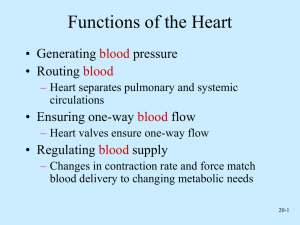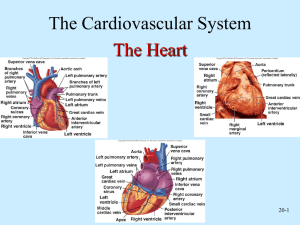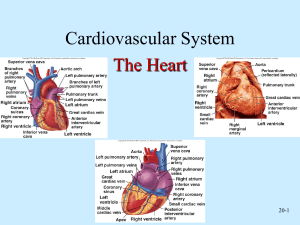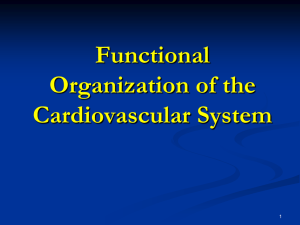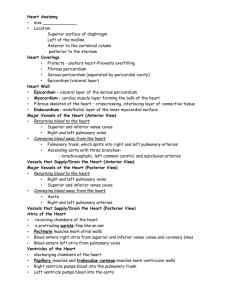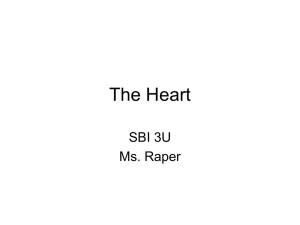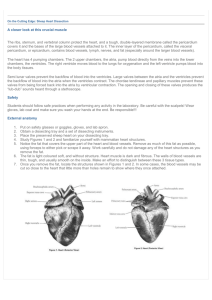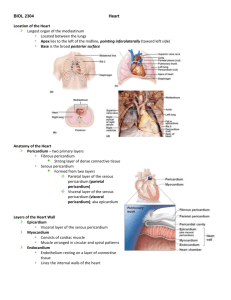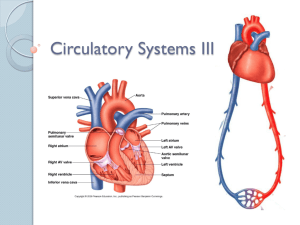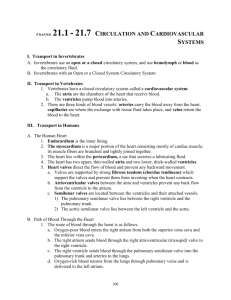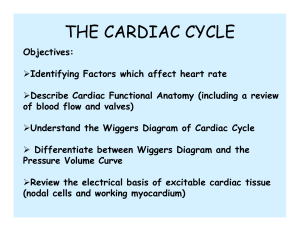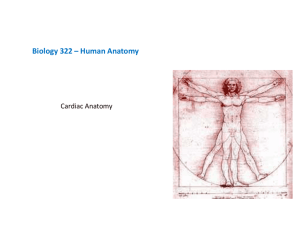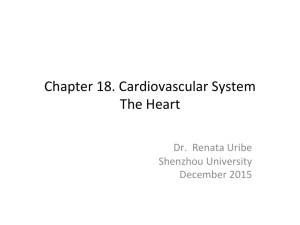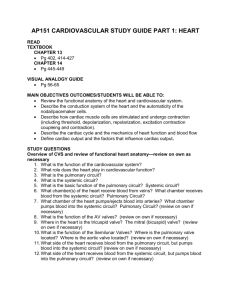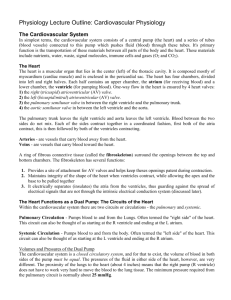The Heart ppt notetaking frame - Westgate Mennonite Collegiate
advertisement
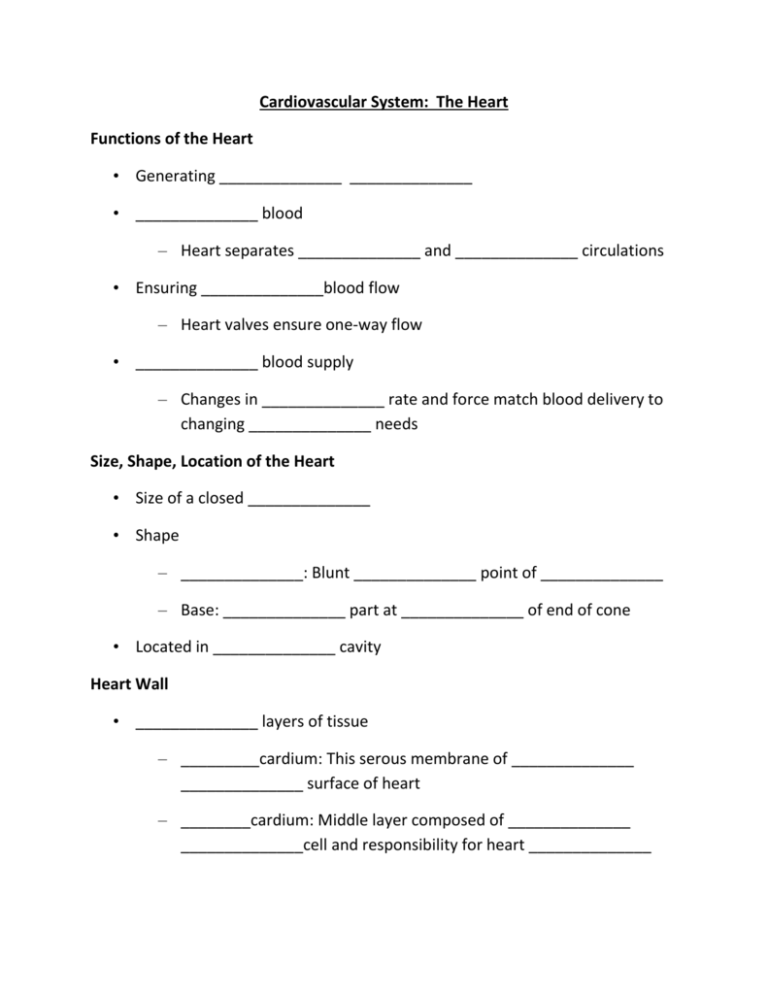
Cardiovascular System: The Heart Functions of the Heart • Generating ______________ ______________ • ______________ blood – Heart separates ______________ and ______________ circulations • Ensuring ______________blood flow – Heart valves ensure one-way flow • ______________ blood supply – Changes in ______________ rate and force match blood delivery to changing ______________ needs Size, Shape, Location of the Heart • Size of a closed ______________ • Shape – ______________: Blunt ______________ point of ______________ – Base: ______________ part at ______________ of end of cone • Located in ______________ cavity Heart Wall • ______________ layers of tissue – _________cardium: This serous membrane of ______________ ______________ surface of heart – ________cardium: Middle layer composed of ______________ ______________cell and responsibility for heart ______________ – ________cardium: Smooth ______________ surface of heart ______________ External Anatomy • ______________ chambers – 2 atria – 2 ______________ • Auricles • Major ______________ – Superior ______________ ______________ – ______________ veins • Major arteries – ______________ – Pulmonary ______________ Heart Valves • Atrioventricular – ______________ – ______________ or mitral • Semilunar – ______________ – ______________ • Prevent blood from flowing ______________ Blood Flow Through Heart 1. What is another term for the bicuspid valve? 2. Write out the path of the blood starting at the superior vena cava and inferior vena cava and back. Systemic and Pulmonary Circulation Write out the path of the blood starting in the right side of the heart and back. Heart Skeleton • Consists of plate of ______________ connective tissue between ______________ and ______________ • Fibrous ______________ around ______________ to support • Serves as ______________ ______________ between atria and ventricles • Provides site for ______________ attachment Conducting System of Heart Write out the path of the electrical stimulation from start to finish. Refractory Period • Absolute: ______________ muscle cell completely ______________ to further stimulation • Relative: Cell exhibits ______________ sensitivity to additional stimulation • ______________ refractory period prevents tetanic ______________ Electrocardiogram • ______________ potentials through ______________ during cardiac cycle produces ______________ currents than can be measured • Pattern – P wave • Atria ______________ – QRS complex • Ventricle ______________ • Atria ______________ – T wave: • Ventricle ______________ Cardiac Arrhythmias • Tachycardia: Heart rate in excess of 100bpm • Bradycardia: Heart rate less than 60 bpm • Sinus arrhythmia: Heart rate varies 5% during respiratory cycle and up to 30% during deep respiration • Premature atrial contractions: Occasional shortened intervals between one contraction and succeeding, frequently occurs in healthy people Cardiac Cycle • Heart is two pumps that work together, right and left half • Repetitive contraction (systole) and relaxation (diastole) of heart chambers • Blood moves through circulatory system from areas of higher to lower pressure. – Contraction of heart produces the pressure Heart Sounds • First heart sound or “lubb” – Atrioventricular valves and surrounding fluid vibrations as valves close at beginning of ventricular systole • Second heart sound or “dupp” – Results from closure of aortic and pulmonary semilunar valves at beginning of ventricular diastole, lasts longer • Third heart sound (occasional) – Caused by turbulent blood flow into ventricles and detected near end of first one-third of diastole Mean Arterial Pressure (MAP) • Average blood pressure in aorta • MAP=CO x PR – CO is amount of blood pumped by heart per minute • CO=SV x HR – SV: Stroke volume of blood pumped during each heart beat – HR: Heart rate or number of times heart beats per minute • Cardiac reserve: Difference between CO at rest and maximum CO – PR is total resistance against which blood must be pumped Factors Affecting MAP Regulation of the Heart • Intrinsic regulation: Results from normal functional characteristics, not on neural or hormonal regulation – Starling’s law of the heart • Extrinsic regulation: Involves neural and hormonal control – Parasympathetic stimulation • Supplied by vagus nerve, decreases heart rate, acetylcholine secreted – Sympathetic stimulation • Supplied by cardiac nerves, increases heart rate and force of contraction, epinephrine and norepinephrine released Heart Homeostasis • Effect of blood pressure – Baroreceptors monitor blood pressure • Effect of pH, carbon dioxide, oxygen – Chemoreceptors monitor • Effect of extracellular ion concentration – Increase or decrease in extracellular K+ decreases heart rate • Effect of body temperature – Heart rate increases when body temperature increases, heart rate decreases when body temperature decreases Effects of Aging on the Heart • Gradual changes in heart function, minor under resting condition, more significant during exercise • Hypertrophy of left ventricle • Maximum heart rate decreases • Increased tendency for valves to function abnormally and arrhythmias to occur • Increased oxygen consumption required to pump same amount of blood Cardiovascular System: The Heart Functions of the Heart • Generating blood pressure • Routing blood – • Ensuring one-way blood flow – • Heart separates pulmonary and systemic circulations Heart valves ensure one-way flow Regulating blood supply – Changes in contraction rate and force match blood delivery to changing metabolic needs Size, Shape, Location of the Heart • Size of a closed fist • Shape • – Apex: Blunt rounded point of cone – Base: Flat part at opposite of end of cone Located in thoracic cavity Heart Wall • Three layers of tissue – Pericardium: This serous membrane of smooth outer surface of heart – Myocardium: Middle layer composed of cardiac muscle cell and responsibility for heart contracting – Endocardium: Smooth inner surface of heart chambers External Anatomy • • Four chambers – 2 atria – 2 ventricles Auricles • • Major veins – Superior vena cava – Pulmonary veins Major arteries – Aorta – Pulmonary trunk Heart Valves • • • Atrioventricular – Tricuspid – Bicuspid or mitral Semilunar – Aortic – Pulmonary Prevent blood from flowing back Blood Flow Through Heart Systemic and Pulmonary Circulation Heart Skeleton • Consists of plate of fibrous connective tissue between atria and ventricles • Fibrous rings around valves to support • Serves as electrical insulation between atria and ventricles • Provides site for muscle attachment Conducting System of Heart Refractory Period • Absolute: Cardiac muscle cell completely insensitive to further stimulation • Relative: Cell exhibits reduced sensitivity to additional stimulation • Long refractory period prevents tetanic contractions Electrocardiogram • Action potentials through myocardium during cardiac cycle produces electric currents than can be measured • Pattern – P wave • – – Atria depolarization QRS complex • Ventricle depolarization • Atria repolarization T wave: • Ventricle repolarization Cardiac Arrhythmias • Tachycardia: Heart rate in excess of 100bpm • Bradycardia: Heart rate less than 60 bpm • Sinus arrhythmia: Heart rate varies 5% during respiratory cycle and up to 30% during deep respiration • Premature atrial contractions: Occasional shortened intervals between one contraction and succeeding, frequently occurs in healthy people Cardiac Cycle • Heart is two pumps that work together, right and left half • Repetitive contraction (systole) and relaxation (diastole) of heart chambers • Blood moves through circulatory system from areas of higher to lower pressure. – Contraction of heart produces the pressure Heart Sounds • First heart sound or “lubb” – • Second heart sound or “dupp” – • Atrioventricular valves and surrounding fluid vibrations as valves close at beginning of ventricular systole Results from closure of aortic and pulmonary semilunar valves at beginning of ventricular diastole, lasts longer Third heart sound (occasional) – Caused by turbulent blood flow into ventricles and detected near end of first one-third of diastole Mean Arterial Pressure (MAP) • Average blood pressure in aorta • MAP=CO x PR – CO is amount of blood pumped by heart per minute • • – CO=SV x HR – SV: Stroke volume of blood pumped during each heart beat – HR: Heart rate or number of times heart beats per minute Cardiac reserve: Difference between CO at rest and maximum CO PR is total resistance against which blood must be pumped Factors Affecting MAP Regulation of the Heart • Intrinsic regulation: Results from normal functional characteristics, not on neural or hormonal regulation – • Starling’s law of the heart Extrinsic regulation: Involves neural and hormonal control – Parasympathetic stimulation • – Supplied by vagus nerve, decreases heart rate, acetylcholine secreted Sympathetic stimulation • Supplied by cardiac nerves, increases heart rate and force of contraction, epinephrine and norepinephrine released Heart Homeostasis • Effect of blood pressure – • Effect of pH, carbon dioxide, oxygen – • Chemoreceptors monitor Effect of extracellular ion concentration – • Baroreceptors monitor blood pressure Increase or decrease in extracellular K+ decreases heart rate Effect of body temperature – Heart rate increases when body temperature increases, heart rate decreases when body temperature decreases Effects of Aging on the Heart • Gradual changes in heart function, minor under resting condition, more significant during exercise • Hypertrophy of left ventricle • Maximum heart rate decreases • Increased tendency for valves to function abnormally and arrhythmias to occur • Increased oxygen consumption required to pump same amount of blood
